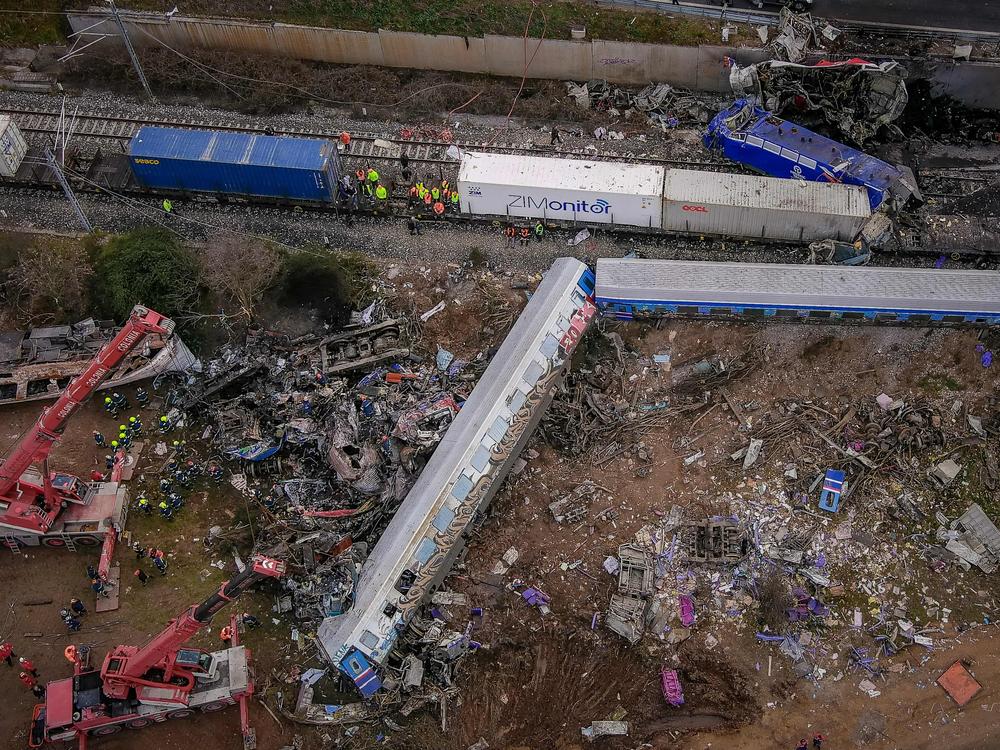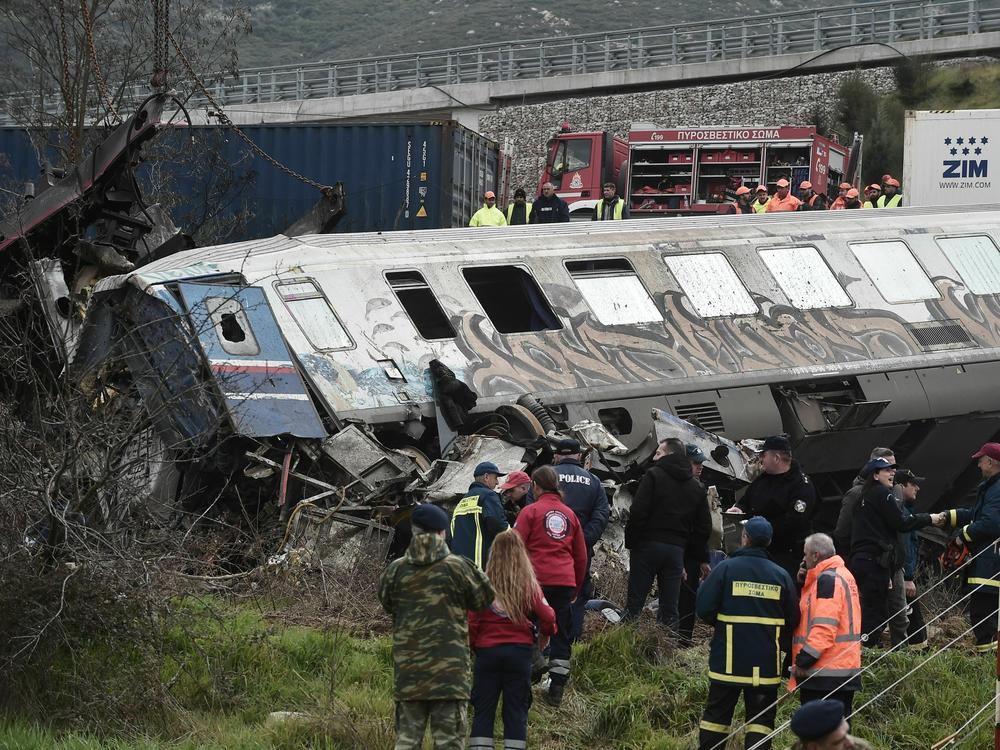Section Branding
Header Content
Greek prime minister says 'human error' caused a train collision that left 43 dead
Primary Content
Updated March 1, 2023 at 2:57 PM ET
At least 43 people are dead and 57 have been hospitalized after a passenger train and a freight train collided on Tuesday night (local time) near the city of Larissa in Greece, according to local authorities.
Photos and video of the scene from Wednesday morning showed rescuers still maneuvering through twisted wreckage, searching for survivors.
By midday, with hope fading, investigators had begun turning to what caused this crash. The country's prime minister said in a televised address that "human error" was largely to blame.
Here's a rundown of what we know.
How did the trains collide?
According to the national rail operator, the passenger train was carrying roughly 350 people at the time of the collision, traveling at high speed from Athens to Thessaloniki, Greece's second-largest city.
The Associated Press reported that many of those passengers were students returning from Carnival, a three-day festival that precedes the religious season of Lent. The freight train was likely carrying construction material, such as heavy steel plates, according to Greece's public media agency, ERT.
Though the trains appeared to be traveling on a double-track line, both trains appeared to be moving on the same track, heading towards each other. The trains collided, head-on, just before midnight local time, as the passenger train was exiting a tunnel under a highway in the municipality of Tempe.
Local media reports citing survivors suggest that the first two carriages of the passenger train were sent flying into the air, twisting backward and catching fire, leaving them completely disintegrated by morning.
The remaining line of carriages buckled and slid off the tracks, sending dozens of dazed people escaping into the dark.
What is the death toll?
As of Wednesday morning, rescue workers were still sorting through the mass of metal, searching for signs of life.
More than 150 firefighters and paramedics are on the scene, said Greek Fire Service spokesperson Vassilis Varthakogiannis in a media briefing. The crews are using cranes and construction equipment to help move some of the heaviest chunks of steel.
Most survivors of the crash were bused to Thessaloniki, where police took names to track the missing, Varthakogiannis said.
Greece's firefighting service said 57 people remained hospitalized late Wednesday, including six in intensive care, the Associated Press reported. More than 15 others were discharged after receiving initial treatment.
Greek authorities said at least 43 people had died, but the toll is expected to rise as more victims are identified, a task that's been complicated because temperatures exceeded 2,300 degrees Fahrenheit when fires broke out in the first three carriages.
Greece's prime minister has declared three days of national mourning in the country.
What do we know about the cause?
In an address to the nation Wednesday, Prime Minister Kriakos Mitsotakis announced the formation of a cross-party committee of experts that would investigate the causes of the collision.
Mitsotakis said the committee would explore "perennial delays" in critical railway projects, but that "everything shows the drama is due, unfortunately, largely to tragic human error."
Several media outlets reported earlier that the stationmaster from the city of Larissa was arrested and charged with manslaughter by negligence. The 59-year-old Hellenic Train employee originally denied any wrongdoing.
But ERT news, citing unnamed police sources, reported that the stationmaster later admitted he made an error directing the trains as the result of a power cable explosion at a nearby station on Tuesday afternoon.
Earlier in the day, a 25,000-volt power cable exploded and fell onto a train at the Paleofarsolas station, causing a three-hour delay on the Athens-Thessaloniki route, ERT reported.
On Tuesday evening, the Larissa stationmaster guided the passenger train onto the descending line of tracks to avoid electric shock. The train returned to the ascending line after Larissa, but then again was guided onto the descending line, where it collided with the freight train.
The country's transport minister, Kostas Karamanlis, resigned on Wednesday after visiting the crash scene, saying he inherited the country's railway "in a state that does not suit the 21st century," and his efforts to improve it were "not enough to prevent such an accident."
As part of Greece's international bailout amidst an economic crisis, the country privatized its rail system in 2017, selling its lines to the Italian state railway group, Ferrovie dello Stato.
Mitsotakis said in his address that the current minister of state would step in to replace Karamanlis as transport minister during the investigation. Mitsotakis also said the head of the national rail agency had resigned.
"Justice will do its own work. Responsibilities will be assigned," Mitsotakis said of the investigation. "We will work so that this 'never again' that I heard in Larissa will not remain an empty word."
Hellenic Train, the line's operator, canceled dozens of its scheduled routes for Wednesday, saying in a statement that its "primary and exclusive concern" for the moment is to complete the evacuation and rescue process.
Copyright 2023 NPR. To see more, visit https://www.npr.org.


